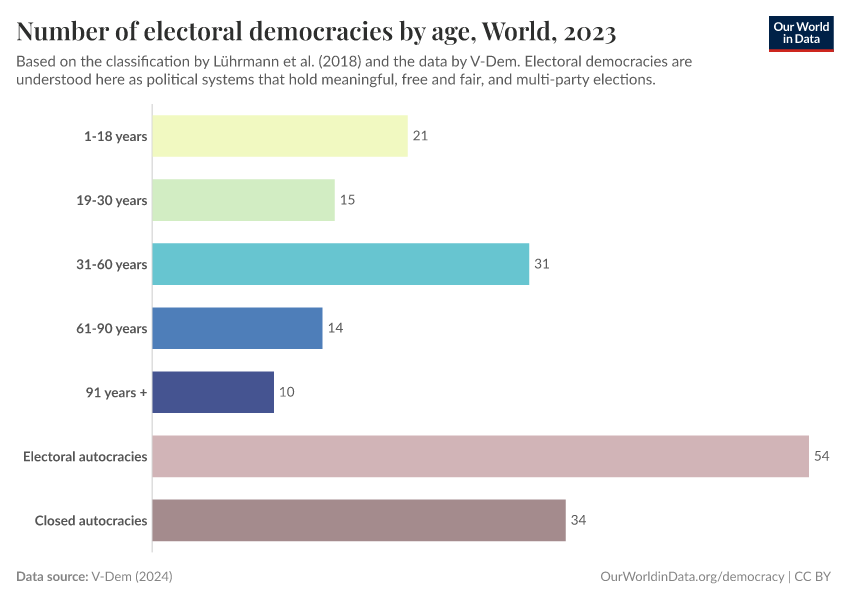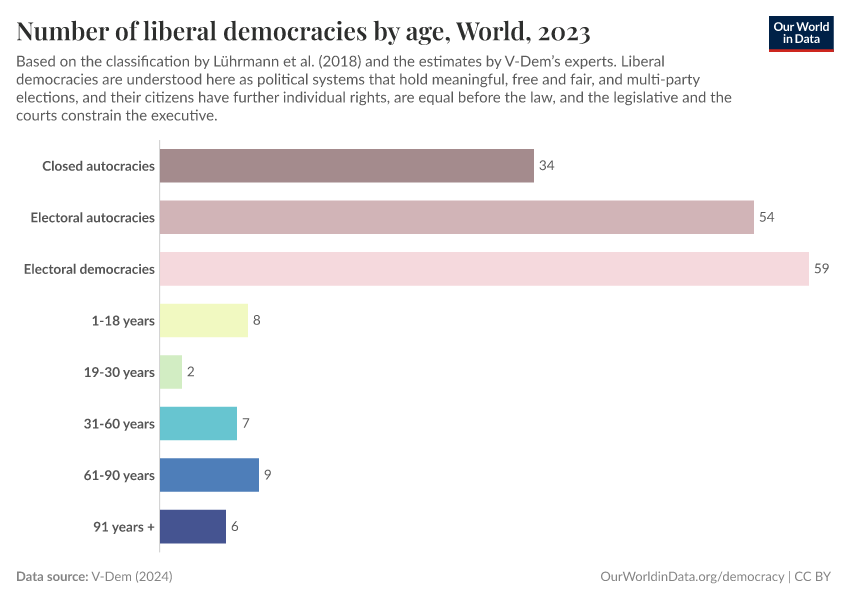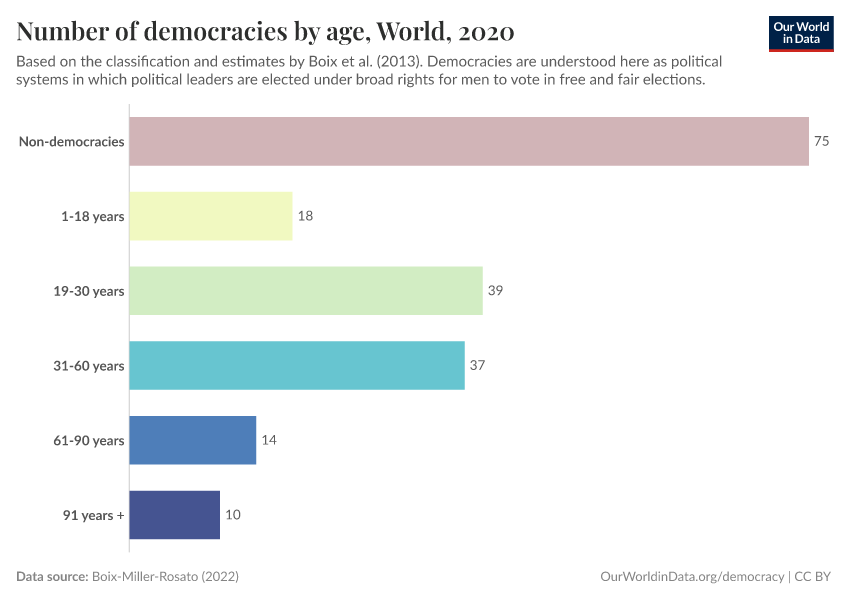In most countries, democracy is a recent achievement. Dictatorship is far from a distant memory
How old are democracies across the world?
To young people living in democracies, authoritarianism may seem like a long-forgotten part of their country’s history. For as long as they can remember, their fellow citizens have had the right to voice their opinion and to organize freely, political parties have competed in meaningful elections, and the legislature and courts have checked their governments’ actions.
But these experiences are far from universal. Many countries are not democracies; and most countries that are democratic are younger than a lifetime. This means that for most people, life under authoritarianism is either their current experience, or they remember a time when it was.
How can researchers measure the age of democracies?
Identifying which countries are democracies comes with many challenges. People disagree about what characterizes a democracy, and whether actual political systems can even come close to such an ideal. If they agree on what democracy is and that countries can come meaningfully close to it, its characteristics — such as whether an election is free and fair — still are difficult to assess. If knowledgeable researchers can be found, their assessments are still to some degree subjective, and they may disagree with others. Even if researchers align in their assessment of specific characteristics of a political system, they may disagree about how to reduce the complexity of these many characteristics into a single variable: a binary measure that says whether a country is a ‘democracy’ or not.
Because of these difficulties, classifying political systems is unavoidably controversial.
In our work we therefore rely on sources that work hard to address these many challenges, and are transparent, so that they can be interrogated and criticized by those who disagree. We also use multiple sources to see how the assessments of different researchers compare.
The first source we use here is the Regimes of the World (RoW) classification by political scientists Anna Lührmann, Marcus Tannenberg and Staffan Lindberg.1 The classification uses data from the Varieties of Democracy (V-Dem) project2 and distinguishes between two types of democracies: electoral democracies and liberal democracies.
In electoral democracies, citizens have the right to participate in meaningful, free and fair, multi-party elections. Liberal democracies go further: citizens have individual and minority rights, equality before the law, and the actions of the executive are constrained by the legislature and the courts.3
While we use RoW’s classification and V-Dem’s data, we expand the years and countries covered and refine the coding rules. This article details how RoW measures democracies, which changes we made, and what shortcomings and strengths the measure has.
Although RoW allows us to look at two different understandings of democracy, Lührmann et al. (2018) acknowledge that it is a demanding measure of democracy: RoW has high standards for how free, fair, and meaningful elections have to be to classify as a democracy.4 It therefore classifies some political systems with limited flaws, such as some restrictions on the freedoms of expression and association, as autocratic. Other measures are more accepting of such flawed elections and consider these political systems as sufficiently democratic.
One alternative source we use here is the BMR classification by political scientists Carles Boix, Michael Miller, and Sebastian Rosato.5 The classification distinguishes between democracies, in which political leaders are elected under broad suffrage in free and fair elections, and non-democracies, which do not meet these criteria.6 They apply the classification to 222 countries, some of which they cover as far back as 1800.7
To calculate the age of democracy in a country, we count the number of years since a country is considered democratic, looking in turn at electoral democracies and liberal democracies based on RoW, and democracies as identified by BMR. If the classification categorizes the country as non-democratic at any point, the age of its democracy is set back to zero.
Just over half of countries are democracies today
The interactive map shows how old electoral democracy was in each country in 2024 when using the RoW classification. The bar chart sums up the number of countries by age.
Based on this classification and the assessments of V-Dem’s experts, we see that only half of all countries were democracies in 2024: of the 179 countries for which data is available, 88 held meaningful, free and fair, and multi-party elections.
This means that for the people living in the other 91 countries, authoritarian government is not a memory at all, but their current experience.
To explore how the ages of democracies and their frequencies have changed over time, you can drag the time-slider below the charts as far back as 1789, when no country was democratic.8
Most democracies are young
The data shows that democracy is young in most of the countries that are democratic today.
Many democracies are less than a generation old. Twenty of them are younger than 18, not older than a child. These include the democracies in Malawi, Moldova, Nepal, or Sri Lanka. Others are only as old as the country’s young adults, such as the democracies in Croatia, Mexico, South Africa, and Taiwan.
This means that in these countries even most young people have experienced authoritarian rule, and that older people have lacked democratic political rights for a large part of their lives.
A larger group of countries have been electoral democracies for one to three generations. This includes the democracies in Botswana, Costa Rica, Italy, Portugal and Spain.
In these countries, children and young adults have only known life in a democracy. But their parents and grandparents, and thus large parts of the population, have still experienced non-democratic rule.
Only a few countries have been electoral democracies for a long time. Seven countries — Canada, Iceland, Ireland, New Zealand, Sweden, the United Kingdom, and the United States — have been electoral democracies for a century or more. And according to this data, just two countries have been electoral democracies even longer: Australia and Switzerland have been democracies since the mid-19th century.
Democracy in these countries is therefore older than all or close to all of their citizens. This does not mean, however, that everyone in these countries has enjoyed democratic political rights since then. For example, the Australian and Swiss governments forbade women to vote and stand in elections until 1902 and 1971, respectively.
Liberal democracy is an even more recent achievement
If we look at liberal democracies, defined in the RoW-classification as political systems in which citizens have further individual and minority rights in addition to the meaningful, free and fair, multi-party elections that characterize electoral democracies, we see that they are an even rarer and more recent achievement.9
In the interactive map and bar chart we see the age of liberal democracy in any given country and their frequencies by year.8 In 2023, only 29 of the 179 countries covered were considered to be liberal democracies.
These liberal democracies split evenly into four age groups: democracies the age of children or young adults, such as Chile, Estonia, and South Africa; middle-aged democracies, including Costa Rica, Italy, and the United States; democracies the age of senior citizens, such as France, Germany, and Japan; and even older liberal democracies: this includes Australia, New Zealand, and Sweden. The outlier by far is Switzerland, which the RoW classification categorizes as a liberal democracy without interruption since the middle of the 19th century.
Democracy is a recent achievement regardless of the measure used
As emphasized earlier in this article, researchers come to different conclusions about whether a country should be considered democratic or not.
This becomes clear when we compare the RoW classification — which we just looked at — with the classification by Carles Boix, Michael Miller, and Sebastian Rosato (BMR). One example of where the classifications disagree is India. RoW considers the country to have been an electoral autocracy in 1975 and 1976, and since 2017. This is because its classification emphasizes freedoms of association and expression in addition to the freedom and fairness of elections. V-Dem’s experts deem these to have declined during those years.10 The BMR classification disagrees with this assessment and considers India to have been continuously democratic since 1950.
But, overall, a comparison of sources shows broad agreement, and we see that the BMR classification agrees that democracy is a recent achievement in most countries.
The interactive map and bar chart again display the age of democracy in each country and their frequencies by year.
The data shows that in 2020, the BMR classification considers more countries to have been minimally democratic than in RoW’s classification: 118 of the 193 countries covered were considered to have been electoral democracies. This includes small countries which RoW does not cover, such as Andorra and Saint Lucia, plus countries such as Hungary and the aforementioned India which RoW does cover, but recently classifies as electoral autocracies.
Among the democracies classified as such by BMR, those aged one or two generations are especially common. This includes countries categorized the same based on RoW, such as Indonesia, Mexico, and South Africa; and it includes some democracies RoW considers to be younger, such as the Dominican Republic and Ukraine.
While the measures for some countries disagree about whether they are democracies, and for how long they have been so, the measures agree in their assessment of many others. And importantly, they agree that few countries that are democratic are older than two generations.11
Ultimately, regardless of the measure used, the data shows that many people have experienced non-democratic rule in their lifetimes.
In almost all countries, non-democratic rule is far from a distant memory
Electoral and liberal democratic political rights are recent achievements in the countries where citizens have them.
Countries such as the United Kingdom, in which democracy is older than almost all of its citizens, are rare; and even countries such as Spain have democracies which are younger than many of its older citizens.
The experience of young people living in democracies in Western Europe or North America is therefore a fairly unique one: it is not representative of other people’s experiences — not of older citizens in their own country, or of people in other parts of the world.
Democracy’s spread is largely a recent achievement, and dictatorship is far from a distant memory for people in almost all countries. It instead is either still with them, and a part of their daily life; or it is not forgotten, and part of their own or their older relatives’ memories.
Keep reading at Our World in Data
Democracy
How has democracy spread across countries? Are we moving towards a more democratic world? Explore global data and research on democracy.
Acknowledgements
I thank Marcus Tannenberg and Johannes von Römer for providing data and code for this article, and the Our World in Data team for reading drafts of this text and for very helpful comments and ideas.
Endnotes
Lührmann, Anna, Marcus Tannnberg, and Staffan Lindberg. 2018. Regimes of the World (RoW): Opening New Avenues for the Comparative Study of Political Regimes. Politics and Governance 6(1): 60-77.
Coppedge, Michael, John Gerring, Carl Henrik Knutsen, Staffan I. Lindberg, Jan Teorell, David Altman, Fabio Angiolillo, Michael Bernhard, Agnes Cornell, M. Steven Fish, Linnea Fox, Lisa Gastaldi, Haakon Gjerløw, Adam Glynn, Ana Good God, Sandra Grahn, Allen Hicken, Katrin Kinzelbach, Joshua Krusell, Kyle L. Marquardt, Kelly McMann, Valeriya Mechkova, Juraj Medzihorsky, Natalia Natsika, Anja Neundorf, Pamela Paxton, Daniel Pemstein, Johannes von Römer, Brigitte Seim, Rachel Sigman, Svend-Erik Skaaning, Jeffrey Staton, Aksel Sundström, Marcus Tannenberg, Eitan Tzelgov, Yi-ting Wang, Felix Wiebrecht, Tore Wig, Steven Wilson and Daniel Ziblatt. 2025. "V-Dem [Country-Year/Country-Date] Dataset v15" Varieties of Democracy (V-Dem) Projectf
The classification also distinguishes two types of autocracies: electoral autocracies, in which citizens have the right to choose the chief executive and the legislature through multi-party elections, but they lack some freedoms, such as the freedoms of association or expression, that make the elections meaningful, free, and fair; and closed autocracies, in which citizens do not have the right to choose through multi-party elections either the chief executive of the government or the legislature.
”[A] comparison of disagreements with extant datasets (7%–12% of the country-years), demonstrates that the RoW classification is more conservative, classifying regimes with electoral manipulation and infringements of the political freedoms more frequently as electoral autocracies.” (Lührmann et al. 2018: 60).
Boix, Carles, Michael Miller, and Sebastian Rosato. A Complete Data Set of Political Regimes, 1800–2007. Comparative Political Studies 46(12):1523-1554.
Specifically, three criteria have to be met: 1.) the executive has to be directly or indirectly elected in popular elections, and has to be responsible to voters or a legislature; 2.) the legislature (and the executive if it is elected directly) has to be chosen in free and fair elections; and 3.) a majority of adult men has to have the right to vote.
This chart shows how each country is classified at the end of each year.
The number of countries that are closed autocracies increases a lot in 1900 because V-Dem starts to cover many more countries, often colonies.
You can read more about what liberal-democratic political systems are and how we measure them in our article about the RoW data.
You can read more in V-Dem’s 2021 annual report Autocratization Turns Viral.
The outlier in the BMR classification is the United States, which has been classified as an electoral democracy since the beginning of the 19th century.
Cite this work
Our articles and data visualizations rely on work from many different people and organizations. When citing this article, please also cite the underlying data sources. This article can be cited as:
Bastian Herre (2022) - “In most countries, democracy is a recent achievement. Dictatorship is far from a distant memory” Published online at OurWorldinData.org. Retrieved from: 'https://ourworldindata.org/democracies-age' [Online Resource]BibTeX citation
@article{owid-democracies-age,
author = {Bastian Herre},
title = {In most countries, democracy is a recent achievement. Dictatorship is far from a distant memory},
journal = {Our World in Data},
year = {2022},
note = {https://ourworldindata.org/democracies-age}
}Reuse this work freely
All visualizations, data, and code produced by Our World in Data are completely open access under the Creative Commons BY license. You have the permission to use, distribute, and reproduce these in any medium, provided the source and authors are credited.
The data produced by third parties and made available by Our World in Data is subject to the license terms from the original third-party authors. We will always indicate the original source of the data in our documentation, so you should always check the license of any such third-party data before use and redistribution.
All of our charts can be embedded in any site.





